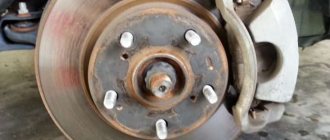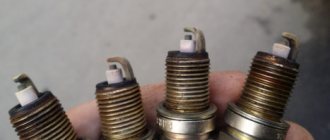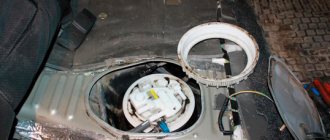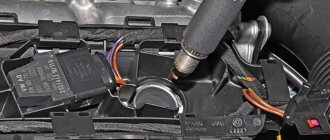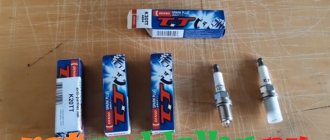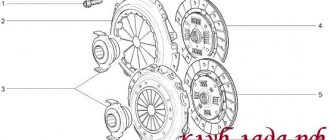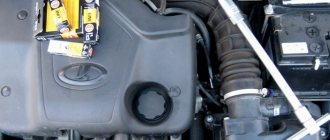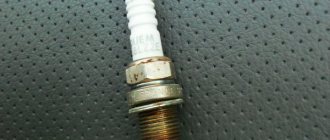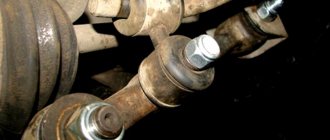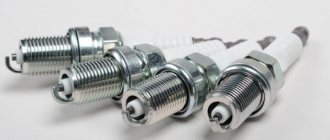Spark plugs are an engine element, the proper operation of which affects the operation of the engine, and therefore the vehicle. The uninterrupted operation of these units ensures that there are no gaps in the starting system and, as a result, proper power, as well as normal fuel consumption.
Replacing spark plugs on a Toyota Corolla is a periodically necessary procedure. The car owner independently decides which parts to use - original parts or budget analogues. As a rule, updating the ignition elements on your own is not difficult, Corolla is no exception in this regard.
Candle life
If we look at the regulations from Toyota, the service life of the spark plugs depends on the engine:
- for a 1.4 liter engine - about 40 thousand kilometers.
- for a 1.6 liter engine - 80-100 thousand kilometers.
Naturally, we are talking about original elements. Also, this replacement period is designed to use high-quality fuel. During the operation of the spark plugs, the electrodes burn out, and the gap also increases, which leads to the formation of misfires. If the spark plugs are not replaced on time, then increased gasoline consumption may be observed, and the internal combustion engine will start poorly or stop doing so altogether.
How to distinguish the original from analogues
Since 2007, on the domestic market of ignition elements there is a huge number of fakes that look exactly the same as the original ones, but have a quality that is much worse. There are several subtleties in order to distinguish the original from fake candles:
- There should be no bubbles on the white insulator.
- The inscription on the insulator should not be erased with a fingernail.
- There should be no small chips on the edges, as, for example, in this photo:
- Side engraving should be applied evenly. Watch the engraving mark while rotating the candle in your hands. Here's an example of a fake:
- The ring should not unscrew.
- There will be small burrs on the threads.
- The electrode gap will not be centered.
Signs of faulty spark plugs
The main symptoms that may indicate the need to replace spark plugs:
- increased gasoline consumption;
- at idle, extraneous engine vibrations are observed (as a rule, accompanied by a blinking “Check Engine”);
- weak acceleration dynamics;
- failures during acceleration;
- idle speed floats;
- Computer diagnostics revealed misfires.
It is important to understand that such symptoms do not indicate problems with the spark plugs; for example, they may indicate problems with the ignition coils and other malfunctions of the internal combustion engine.
What are they needed for?
Spark plugs are understood as special devices that allow ignition of the fuel mixture in the combustion chamber of different types of engines. As a rule, based on their classic version, the mixture ignites through an electric discharge running between the electrodes located at the end of the spark plug. We won't talk about the building itself. You can study it from the inside yourself. To do this, you need to look at the picture below. Its structure is not complicated and therefore does not require explanation.
How to choose candles
It is important to rely on their basic parameters to determine which spark plugs are best suited for the engine.
- Thread length and size. It is important to choose the right size (on a turnkey basis), as well as the thread. For a 1.4 liter engine, the thread length should be 26.5 mm, and the size (on a turnkey basis) should be 14 mm. For a 1.6 liter engine, spark plugs with a threaded part diameter of 12 mm are suitable.
- Resistance. For Corolla, this parameter will be equal to 5 kOhm.
- Type of candles. From the factory, 1.4 engines are equipped with simple nickel spark plugs, and 1.6 engines are equipped with iridium spark plugs.
- Gap. For simple spark plugs (1.4 motor) it should be 1 mm, and for iridium spark plugs (1.6 motor) - 1.1 mm.
Main types
Internal combustion engines use several types of spark plugs, differing in the material of the electrodes:
- standard, equipped with 1 side electrode and a central part made of copper alloy;
- improved 1-electrode with nickel core;
- multi-electrode, characterized by the use of 2 or 4 side contacts;
- with a central electrode made of iridium or platinum alloy;
- pre-chamber type products without separate lateral contact.
Original Toyota spark plugs
The table shows original spark plugs for Toyota Corolla 150.
| Motor | Volume | Electrode type | vendor code |
| 4ZZ-FE | 1.4 liters | Nickel | 90919-01164 |
| 1ZR-FE | 1.6 liters | Iridium | 90915-01253 |
Original spark plugs will be the best solution when replacing; they do their job perfectly, have a long service life, and also eliminate any difficulties due to mismatched characteristics.
Factors affecting spark plug wear
- Fuel. Low-quality gasoline is the main enemy of spark plugs. Because of it, a strong soot forms, which is difficult to break through with a spark. For normal operation of the ignition system, a minimum of 95 gasoline is recommended.
- Driving style. Aggressive driving puts enormous stress not only on the piston group, but also on the ignition system. The higher the engine speed, the more often the ignition elements generate a spark, and therefore wear out faster.
- Brand. Like any spare part, original ones will last many times longer than fakes. Spark plugs are inexpensive items that you shouldn’t skimp on, because their poor condition can have a detrimental effect on your car’s engine.
Analogs
If you can’t purchase the original or you need to save money on buying candles, you can use various compatibility catalogs, with the help of which you can accurately select the appropriate option. It is advisable not to choose options that are too cheap, since they mostly use cheap materials, which has a bad effect on their resource.
The table shows good analogs for the 1.4 liter engine.
| Brand | vendor code |
| Bosch | 0242229798 |
| Denso | 4603 |
| Champion | OE063/T10 |
| NGK | 2756 |
| NGK | 3764 |
Below you can find good analogues for the 1.6 liter engine.
| Brand | vendor code |
| Denso | IXEH22TT |
| NGK | ILKAR7B-11 |
| Bosch | 0 242 129 529 |
| LYNXauto | SP-152 |
| Hella | 8EH 188 705-161 |
Article number and cost of the original ignition coil for Corolla 150 and its analogues
The branded ignition coil has catalog number 9091902266. The cost of a new product ranges from 3,000 to 5,000 rubles. There is also the opportunity to purchase the product from auto dismantling yards. Since the residual life of a used coil is unknown, experienced owners recommend purchasing analogues from third-party manufacturers. A list of the best options is given in the table below.
Table - Ignition coils for Corolla 150 from third-party manufacturers
| Company manufacturer | Article number | Cost, ruble |
| Mobiletron | CT37 | 2000-2500 |
| Bremi | 20485 | 1600-2000 |
| ERA | 880245 | 1800-2200 |
| Magneti Marelli | 060717119012 | 1400-1800 |
| Janmor | JM5144 | 1300-1550 |
| Delphi | GN1031312B1 | 2000-2400 |
Spark plug replacement procedure
The replacement process is not difficult and absolutely every car enthusiast can handle it. To perform the procedure, you must first make sure that you have the necessary tools:
- spark plug wrench (you can take a 14mm socket with a torque handle and a long tip);
- a magnetic tip or similar tool that can be used to retrieve spare parts that have fallen into wells, if necessary;
- key to 10;
- rags.
The replacement process consists of several simple steps:
- unpack the spark plugs and examine their condition for the absence of visible defects; it is also necessary to remove the protective caps;
- if the engine has just been turned off, then you need to wait until it cools down;
- Use a 10mm wrench to remove the protective plastic from the motor;
- unscrew the coils with a 10 mm wrench or socket;
- remove the connectors from the coils;
- remove the coils and wipe them if necessary;
- unscrew with a special key;
- if you cannot get the spark plug with a key, then you need to use a magnetic or other grip;
- install new spark plugs, if a torque wrench is used, then the required tightening torque is 20 Nm, if there is no wrench, then you need to tighten the spark plug tightly by hand, and then turn it another half turn with the wrench;
- install and connect coils;
- tighten the coils;
- install and secure the protective plastic.
And don’t forget to subscribe to our Telegram channel to receive news
Why change them?
Spark plugs are usually changed when problems arise with the engine.
There are many signs that alert the driver that it is time to change the spark plugs. So, when they become unusable, the engine can lose a significant amount of power - this is due to the fact that the mixture in some cylinders may not ignite. In addition, poor engine starting will certainly occur. The motor can run very hard and vibrate. An increase in fuel consumption is also one of the manifestations of damage to spark plugs. And finally, the dynamics of the car - it changes significantly, the loss of power makes itself felt.
List of works during maintenance 4 (40,000 km)
Repetition of work provided for by TO 1 and TO 2, as well as the implementation of additional procedures. Namely:
Replacing the air filter. As an original filter, a filter with article number 1780121050 is used. The price is 1200 rubles.
Replacing brake fluid and hydraulic clutch (for cars with manual transmission). Any type of DOT4 is suitable for replacing TJ. The volume of liquid poured into the system is slightly more than one liter. The cost of the original brake fluid DOT 4, “Brake & Clutch Fluid”, art. 0882380112, 1 liter volume – 1000 rubles.
Replacing spark plugs.
Checks are the same as during maintenance 2, plus monitoring the level of transmission fluid in the gearbox.
- Checking the level and adding oil to manual and robotic gearboxes.
- Checking the level and adding oil in the automatic transmission.
List of works for mileage 50,000, 70,000, 90,000 km
All work regulations provided for by Maintenance 1 - engine oil change and all related procedures.
Toyota Corolla maintenance cost
| Toyota Corolla E150 maintenance cost | ||
| Maintenance number | Catalog number of spare parts | *Price, rub.) |
| TO 1 | engine oil - 0888080375 oil filter - 90915-10003 cabin filter - 87139-30040 o-ring - 9043012031 | 4240 |
| TO 2 | All consumables for the first maintenance | 4240 |
| TO 3 | Repeat first maintenance | 4240 |
| TO 4 | All work provided for in TO 1, as well as: brake fluid - 0882380112 air filter - 1780121050 spark plugs - 90919-01253 - 9091901164 | 7480/9840 |
| Consumables that change without reference to mileage | ||
| Coolant replacement | 888980070, 888980071, 888980072 | 6000 |
| Changing the oil in manual transmission | 888580606 | 2400 |
| Automatic transmission/CVT oil change, partial replacement | 0888602305 (For U340E) 0888602105 (For K311) | 8600 9600 |
| Replacing the Hinge Belt | 90916-W2029 9091602470 90916-W2018 99366-K0910 | 1900 3300 2200 2800 |
| Replacing the timing chain | 13506-37010 13506-37070 1350622030 | 4800 5200 5900 |
*The average cost is indicated as of prices for the summer of 2022 for Moscow and the region.
Source
Corolla maintenance regulations
Toyota Corolla E150 appeared in 2006. The base platform, as on the previous generation Toyota E120, was the Toyota MC platform. The car was equipped with two engines: 1.4 l - 4ZZ-FE (power 97 hp) and 1.6 - 1ZR-FE (124 hp). MultiMode robotic gearbox .
After restyling in 2010, the car began to be equipped with 1.33 liter engines - 1NR-FE (101 hp) and 1.6 liter (124 hp) and a six-speed gearbox or a four-speed automatic U340E, instead of a robotic one . However, this did not in any way affect the frequency of maintenance of the machine, but only the cost and consumables used.
For the Toyota Corolla E150, in the overall picture of maintenance, the first four can be distinguished; further adventures are cyclical, that is, a repetition of previous periods.
The Toyota Corolla E150 maintenance schedule table is as follows:
| Toyota Corolla E150 fluid volume table | |||||
| Engine | Engine oil (l) | Antifreeze (l) | Manual transmission oil (l) 5/6 stages | ATF automatic transmission (l) | Brake/Clutch (l) |
| 4ZZ-FE | 4,2 | 6,0 | 1,9/2,3 | 2,9 | 0,7 |
| 1ZR-FE | |||||
| 1NR-FE | 3,4 | 5,7 | |||
List of works during maintenance 1 (10,000 km)
Changing the engine oil. Engine oil poured into the Toyota Corolla E150 must comply with the ACEA standard: A3, B3 and B4, according to API: SL/CF. The type of oil should be selected depending on the climate in which the machine is operated, standard: SAE 0W-30, 5W-40. Toyota engine oil “ENGINE OIL 5W-40” is poured from the factory, the catalog number of the package for 1 liter is 0888080376. The price is 700 rubles. The same oil with a canister capacity of 5 liters 0888080375 will cost 3100 rubles.
Replacing the oil filter. For a gasoline engine, the original filter will be Toyota 90915-10003. Price 560 rubles.
Replacing the sealing washer of the drain bolt in the crankcase. The original ring has the article number - 9043012031, costs 100 rubles.
Replacing the cabin filter. When replacing the cabin air purifier filter, the original filter will be from Toyota 87139-30040. Its average cost is 480 rubles.
Checks during maintenance 1 and all subsequent ones:
- Cooling system hoses and connections.
- Fuel lines and connections.
- Covers for constant velocity joints.
- Hydraulic clutch (for vehicles with manual transmission)
- Front and rear suspension
- Wheels and tires.
- Hydraulic brake system.
- Braking mechanisms.
- Brake hydraulic pipelines and their connections.
- Accumulator battery.
- Headlights.
- Glass and headlight washers.
- Cabin ventilation air filter.
- Seat belts, locks and attachment points to the body.
- Locks, hinges, hood latch, body fittings.
- Drainage holes.
